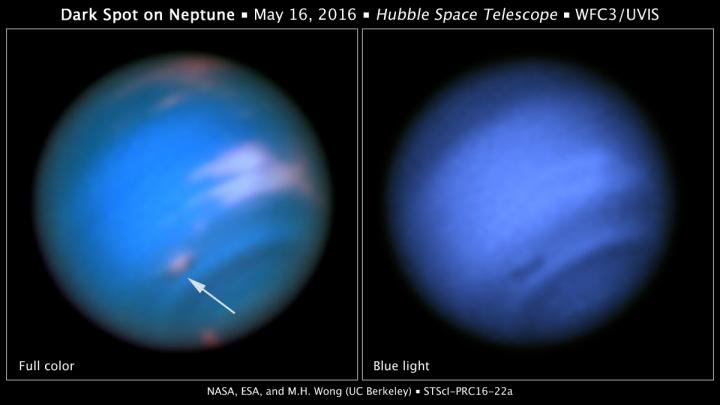Hubble confirms new dark spot on Neptune

This new Hubble Space Telescope image confirms the presence of a dark vortex in the atmosphere of Neptune. On the left, the full visible-light image shows a dark vortex near and below a patch of bright clouds in the planet's southern hemisphere. The dark spot measures roughly 3,000 miles across. On the right, Neptune's dark vortices are typically only best seen at blue wavelengths. Credit: NASA, ESA, and M.H. Wong and J. Tollefson (UC Berkeley)
The discovery was announced on May 17, 2016, in a Central Bureau for Astronomical Telegrams (CBAT) electronic telegram by University of California at Berkeley research astronomer Mike Wong, who led the team that analyzed the Hubble data.
Neptune's dark vortices are high-pressure systems and are usually accompanied by bright “companion clouds,” which are also now visible on the distant planet. The bright clouds form when the flow of ambient air is perturbed and diverted upward over the dark vortex, causing gases to likely freeze into methane ice crystals. “Dark vortices coast through the atmosphere like huge, lens-shaped gaseous mountains,” Wong said. “And the companion clouds are similar to so-called orographic clouds that appear as pancake-shaped features lingering over mountains on Earth.”
Beginning in July 2015, bright clouds were again seen on Neptune by several observers, from amateurs to astronomers at the W. M. Keck Observatory in Hawaii. Astronomers suspected that these clouds might be bright companion clouds following an unseen dark vortex. Neptune's dark vortices are typically only seen at blue wavelengths, and only Hubble has the high resolution required for seeing them on distant Neptune.
In September 2015, the Outer Planet Atmospheres Legacy (OPAL) program, a long-term Hubble Space Telescope project that annually captures global maps of the outer planets, revealed a dark spot close to the location of the bright clouds, which had been tracked from the ground. By viewing the vortex a second time, the new Hubble images confirm that OPAL really detected a long-lived feature. The new data enabled the team to create a higher-quality map of the vortex and its surroundings.
Neptune's dark vortices have exhibited surprising diversity over the years, in terms of size, shape, and stability (they meander in latitude, and sometimes speed up or slow down). They also come and go on much shorter timescales compared to similar anticyclones seen on Jupiter; large storms on Jupiter evolve over decades.
Planetary astronomers hope to better understand how dark vortices originate, what controls their drifts and oscillations, how they interact with the environment, and how they eventually dissipate, according to UC Berkeley doctoral student Joshua Tollefson, who was recently awarded a prestigious NASA Earth and Space Science Fellowship to study Neptune's atmosphere. Measuring the evolution of the new dark vortex will extend knowledge of both the dark vortices themselves, as well as the structure and dynamics of the surrounding atmosphere.
The team, led by Wong, also included the OPAL team (Wong, Amy Simon, and Glenn Orton), UC Berkeley collaborators (Imke de Pater, Joshua Tollefson, and Katherine de Kleer), Heidi Hammel (AURA), Statia Luszcz-Cook (AMNH), Ricardo Hueso and Agustin Sánchez-Lavega (Universidad del Pais Vasco), Marc Delcroix (Société Astronomique de France), Larry Sromovsky and Patrick Fry (University of Wisconsin), and Christoph Baranec (University of Hawaii).
Media Contact
All latest news from the category: Physics and Astronomy
This area deals with the fundamental laws and building blocks of nature and how they interact, the properties and the behavior of matter, and research into space and time and their structures.
innovations-report provides in-depth reports and articles on subjects such as astrophysics, laser technologies, nuclear, quantum, particle and solid-state physics, nanotechnologies, planetary research and findings (Mars, Venus) and developments related to the Hubble Telescope.
Newest articles

Evidence for reversible oxygen ion movement during electrical pulsing
…enabler of the emerging ferroelectricity in binary oxides. In a recent study published in Materials Futures, researchers have uncovered a pivotal mechanism driving the emergence of ferroelectricity in binary oxides….

Next-generation treatments hitch a ride into cancer cells
Researchers from Osaka University discover that opening a channel into cancer cells helps antisense oligonucleotide drugs reach their targets. Antisense oligonucleotides (ASOs) are next-generation drugs that can treat disease by…

Boron deficiency: oilseed rape reacts as with infection and pest infestation
Genetic mechanisms uncovered… Boron deficiency has a devastating effect on oilseed rape and related plants. However, little is known about the underlying genetic mechanisms. A study shows that the response…





















